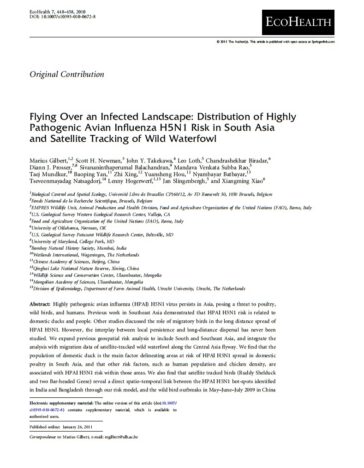
Flying over an infected landscape: distribution of Highly Pathogenic Avian Influenza H5N1 risk in South Asia and satellite tracking of wild waterfowl
-
Species
This study suggests that the continental-scale dynamics of HPAI H5N1 are structured as a number of persistence areas delineated by domestic ducks, connected by rare transmission through migratory waterfowl.
Highly pathogenic avian influenza (HPAI) H5N1 virus persists in Asia, posing a threat to poultry, wild birds, and humans. Previous work in Southeast Asia demonstrated that HPAI H5N1 risk is related to domestic ducks and people. Other studies discussed the role of migratory birds in the long distance spread of HPAI H5N1. However, the interplay between local persistence and long-distance dispersal has never been studied.
We expand previous geospatial risk analysis to include South and Southeast Asia, and integrate the analysis with migration data of satellite-tracked wild waterfowl along the Central Asia flyway. We find that the population of domestic duck is the main factor delineating areas at risk of HPAI H5N1 spread in domestic poultry in South Asia, and that other risk factors, such as human population and chicken density, are associated with HPAI H5N1 risk within those areas.
We also find that satellite tracked birds (Ruddy Shelduck and two Bar-headed Geese) reveal a direct spatio-temporal link between the HPAI H5N1 hot-spots identified in India and Bangladesh through our risk model, and the wild bird outbreaks in May–June–July 2009 in China (Qinghai Lake), Mongolia, and Russia. This suggests that the continental-scale dynamics of HPAI H5N1 are structured as a number of persistence areas delineated by domestic ducks, connected by rare transmission through migratory waterfowl.
Citation: Gilbert M., Newman, S.H., Takekawa JY, Loth L, Biradar C, Prosser DJ, Balachandran S, Subba Rao SV, Mundkur T, Yan B, Xing Z, Hou Y, Batbayar N, Natsagdorj T, Hogerwerf L, Slingenbergh J, Xiao,X (2011) Flying over an infected landscape: distribution of Highly Pathogenic Avian Influenza H5N1 risk in South Asia and satellite tracking of wild waterfowl. Ecohealth. Published Online 26 January 2011. DOI: 10.1007/s10393-010-0672-8

